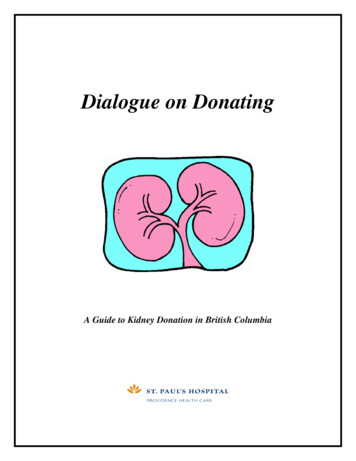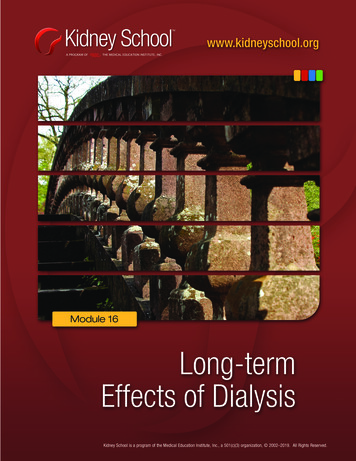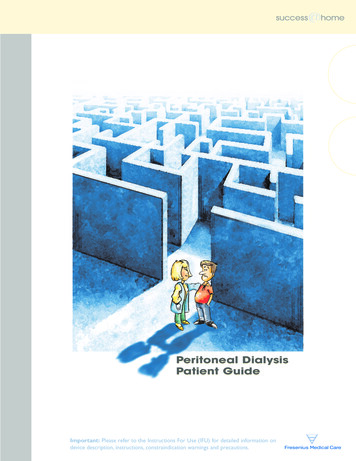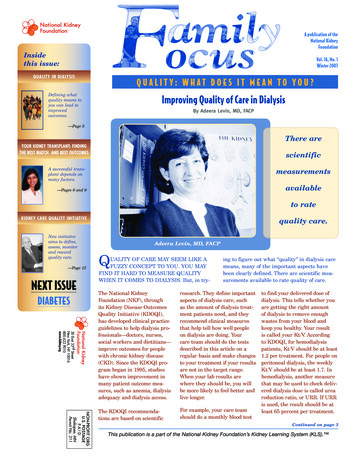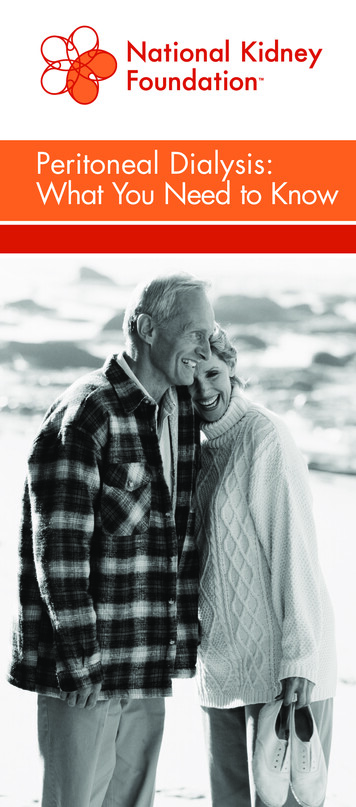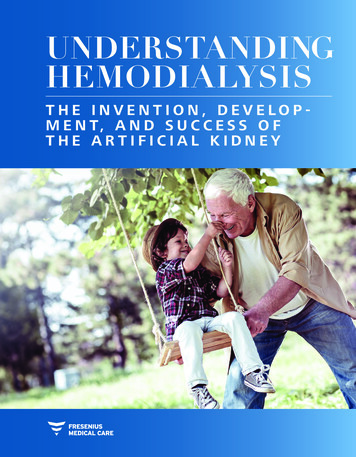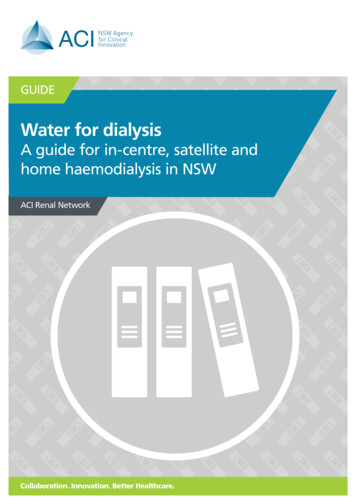
Transcription
GUIDEWater for dialysisA guide for in-centre, satellite andhome haemodialysis in NSWACI Renal NetworkCollaboration. Innovation. Better Healthcare.
The Agency for Clinical Innovation (ACI) works with clinicians, consumers and managers todesign and promote better healthcare for NSW. It does this by: service redesign and evaluation – applying redesign methodology to assist healthcare providers andconsumers to review and improve the quality, effectiveness and efficiency of services s pecialist advice on healthcare innovation – advising on the development, evaluation and adoption ofhealthcare innovations from optimal use through to disinvestment i nitiatives including guidelines and models of care – developing a range of evidence-based healthcareimprovement initiatives to benefit the NSW health system i mplementation support – working with ACI Networks, consumers and healthcare providers to assistdelivery of healthcare innovations into practice across metropolitan and rural NSW nowledge sharing – partnering with healthcare providers to support collaboration, learning capability andkknowledge sharing on healthcare innovation and improvement continuous capability building – working with healthcare providers to build capability in redesign, projectmanagement and change management through the Centre for Healthcare Redesign.ACI Clinical Networks, Taskforces and Institutes provide a unique forum for people to collaborate across clinicalspecialties and regional and service boundaries to develop successful healthcare innovations.A priority for the ACI is identifying unwarranted variation in clinical practice and working in partnership withhealthcare providers to develop mechanisms to improve clinical practice and patient care.www.aci.health.nsw.gov.auAGENCY FOR CLINICAL INNOVATIONLevel 4, 67 Albert AvenueChatswood NSW 2067PO Box 699 Chatswood NSW 2057T 61 2 9464 4666 F 61 2 9464 4728E aci-info@health.nsw.gov.au www.aci.health.nsw.gov.auSHPN: (ACI) 150510, ISBN 978-1-76000-295-4Produced by: Dialysis Working Group of the ACI Renal NetworkFurther copies of this publication can be obtained fromthe Agency for Clinical Innovation website at www.aci.health.nsw.gov.auDisclaimer: Content within this publication was accurate at the time of publication. This work is copyright. It may be reproducedin whole or part for study or training purposes subject to the inclusion of an acknowledgment of the source. It may not bereproduced for commercial usage or sale. Reproduction for purposes other than those indicated above, requires writtenpermission from the Agency for Clinical Innovation.Version: V1.5 TRIM: ACI/D16/2578Date: 12 July 2018 Agency for Clinical Innovation 2018ACI Renal Network – Water for dialysis: A guide for in-centre, satellite and home haemodialysis in NSWPage 2
AcknowledgementsThis Guide was prepared by the ACI Renal Network’s Dialysis Water Quality Sub-Group.MemberRoleLHDMaureen Lonergan (Chair)Renal Physician, Director – Illawarra-Shoalhaven Renal ServiceISLHDJohn LandkaufSenior Renal Technician, Wansey Dialysis Centre,John Hunter HospitalHNELHDLucy SpencerDialysis Nurse Practitioner, Royal North Shore HospitalNSLHDLinda McCorristonCNC, Southern NSW Renal ServiceSNSWLHDSam O’Neill andKellie HardgroveCNC, Hastings Renal Service, Port MacquarieMNCLHDChristopher GibbNurse Manager, Western Renal ServiceWSLHD andNBMLHDJoanne KempNUM, Central Coast Renal Service, GosfordCCLHDDennis WalshSenior Renal Technician, Sydney Dialysis Centre,Royal North Shore HospitalNSLHDRoss WenzelSenior Hospital Scientist, Trace Elements LaboratoryPaLMS, RNSHNSLHDTracey BlowNurse Manager, St George HospitalSESLHDPatrick WasielewskiSenior Renal Technician, Statewide Renal ServicesSLHDJohn SaundersRenal Physician, Royal Prince Alfred HospitalSLHDFidye Westgarth andRama MachirajuRenal Network ManagersACIThis Guide is based on Dialysis Water Pre-treatment for In-Centre and Satellite Haemodialysis Units in NSW: A Set ofGuidelines (2008) which was developed under the auspices of the NSW Greater Metropolitan Clinical Taskforce RenalServices Network. That work was largely produced from the efforts of: Kevin Pull, Engineer, Liverpool Hospital Sydney Mark Seward, Senior Electronics Technician, Hunter Area Dialysis Technical Services Michael Suranyi, Nephrologist, Liverpool Hospital SydneyThe completion of that document was overseen by the Water Guidelines Working Group of the Renal Services Network,and had considerable input from the NSW Senior Hæmodialysis Technicians Group.ACI Renal Network – Water for dialysis: A guide for in-centre, satellite and home haemodialysis in NSWPage 3
ContentsPreface 8PART I: Management of water quality – in-centre and satellite units 9Executive summary: Part I 9Informative 91.1 Scope 101.2 Application 101.3 Innovation 101.4 Exclusion 10Section 1: Scope and general for in-centre and satellite units 101.5 Referenced documents 111.6 Definitions 121.7 Visual Aid: Components 15Section 2: Planning 172.1 General 172.2 Considerations 172.3 Components 182.3.1Feed water temperature control 182.3.2Backflow preventer 182.3.3Multimedia depth filter 192.3.4Water softener 192.3.5Brine tank 202.3.6Ultraviolet irradiator (optional) 212.3.7Carbon filters (tanks) 212.3.8Polishing filter 242.3.9Reverse osmosis systems/ reverse osmosis water plant 242.3.10 Reverse osmosis pump and motor 242.3.11 Reverse osmosis membranes 242.3.12 Submicron and ultrafiltration 252.3.13 Distribution system 262.3.14 Disinfection of the distribution piping systems 262.3.15 Disinfection protection 272.3.16 Deionisers 272.3.17 Drains 27Section 3: Performance requirements 283.1 General 283.2 Water testing 303.2.1Water hardness 313.2.2Chlorine and chloramine (total chlorine) 31ACI Renal Network – Water for dialysis: A guide for in-centre, satellite and home haemodialysis in NSWPage 4
3.2.3Bacteria (CFU) and endotoxin (EU) testing 343.2.4Chemical contaminant and heavy metal levels testing 363.2.5Conductivity testing 373.2.6Residual testing 37Section 4: Quality control 384.1 General 384.2 Policies and procedures 384.2.1Education 384.2.3Obtaining suitable water samples 384.2.4Testing of samples 384.2.5Recording and trending results 394.2.6Identifying trends in results 394.2.7Action when high test results are obtained 394.2.8Work Health and Safety principles 394.2.9Committee meetings 394.2.10 Audits, training and continuing education 394.2.11 Third party involvement 39Section 5: Servicing and maintenance 405.1 General 405.2 Technical considerations 405.2.1Safety requirements 405.2.2Labelling and documentation requirements 405.2.3Device markings 405.2.4Product literature 415.2.5Maintenance literature 415.2.6Water pre-treatment system changes 415.2.7Maintenance and service procedures 425.3 Water utility communications 42Section 6: Recordings 436.1 A model data recording system for chlorine/chloramine measurements 436.2 Decision flow chart for bacterial contamination (CFU) Haemodialysis (HD) machines, distribution loop 446.3 Decision flow chart for bacterial contamination (CFU) Haemodiafiltration (HDF) machines 456.4 Decision flow chart for endotoxin contamination (EU) Haemodialysis (HD) machines, distribution loop 46PART II: Management of water quality – home haemodialysis 47Executive summary: Part II 47Section 7: Scope and general for home haemodialysis 487.1 Scope 487.2 Application 487.3 Innovation 487.4 Referenced documents 49ACI Renal Network – Water for dialysis: A guide for in-centre, satellite and home haemodialysis in NSWPage 5
Section 8: Planning for home haemodialysis 508.1 General 508.2 Considerations 508.3 Components 508.3.1Feed water temperature control 508.3.2Back flow preventer 508.3.3Particle filtration 508.3.4Water softener 508.3.5Carbon filter (tank) 518.3.6Reverse osmosis process 518.3.7Disinfection protection 528.3.8Submicron and ultrafiltration 528.3.9Haemodiafiltration (HDF) at home 52Section 9: Performance requirements 539.1 General 539.1.1Source water/feed water 539.1.2Product water 539.1.3Water for use in haemodiafiltration (HDF) 539.2 Water testing 559.2.1Water hardness 569.2.2Chlorine and chloramine 569.2.3Bacteria and endotoxin testing 579.2.4 Chemical contaminant and heavy metal levels testing Section 10: Quality control – home haemodialysis 575810.1 General 5810.2 Policies and procedures5810.2.1 Operation of water pre-treatment systems5810.2.2 Obtaining suitable water samples5810.2.3 Testing of samples 5810.2.4 Recording results5810.2.5 Action when high test results are obtained5810.2.6 Committee meetings5810.2.7 Work Health and Safety principles 5910.2.8 Audits, training and continuing education 5910.2.9 Third party involvement 59ACI Renal Network – Water for dialysis: A guide for in-centre, satellite and home haemodialysis in NSWPage 6
Section 11: Servicing and maintenance home haemodialysis 6011.1 General 6011.2 Technical considerations 6011.2.1 Safety requirements 6011.2.2 Documentation requirements 6011.2.3 Machine log books 6011.2.4 Training manuals 6011.3 Water utility communications 6011.4 Maintenance 6111.4.1 Feed/source water 6111.4.2 Sediment or particle filters 6111.4.3 Carbon 6111.4.4 Machine ultrafilter 61Appendices 62Appendix I 62Appendix II 63Appendix III 64Appendix IV 66Appendix V 67Appendix VI 77Appendix VII 78Appendix VIII 79Appendix IX 80Appendix X 88ACI Renal Network – Water for dialysis: A guide for in-centre, satellite and home haemodialysis in NSWPage 7
PrefaceThe purpose of this document is to provide guidance for the provision of safe water for patientsreceiving haemodialysis therapy. This includes the design, operation and maintenance for waterpre-treatment and reverse osmosis (RO) water plant/RO systems.Part II contains guidance for water pre-treatment and RO systems for home haemodialysis.Appropriate water quality is one of the most important aspects of ensuring the safe and effective delivery ofhaemodialysis. Haemodialysis may expose the patient to more than 300 litres of water per week across thesemi-permeable membrane of a haemodialyser. Healthy individuals seldom have a weekly oral intake of waterabove 12 litres. The near 30 times increase in water exposure to dialysis patients requires control and monitoring ofwater quality to avoid excesses of known or suspected harmful elements being carried in the water and transmittedto the patient.The water to be used for the preparation of haemodialysis fluids needs treatment to achieve the appropriatequality. The water treatment is provided by a water pre-treatment system, which may include various components,such as sediment filters, water softeners, carbon tanks, micro-filters, ultraviolet disinfection units, reverse osmosis(RO) units, ultrafilters and storage tanks. The components of the system will be determined by the quality of feedwater and the ability of the overall system to produce and maintain appropriate water quality.For home haemodialysis therapy the water treatment is provided by the use of sediment filters, carbon filters and aportable reverse osmosis (RO) plant.Failure to ensure adequate water quality may have dire consequences for patient safety and welfare. Patientsundergoing haemodialysis may show signs and symptoms related to water contamination, which can lead topatient injury or death. Some of the important possible signs and symptoms of water contamination are listedbelow in Table 1.Table 1 Haemodialysis risks associated with water contaminationSymptomsPossible water contaminantsAnaemiaAluminium, chloramine, copper, zincBone diseaseAluminium, fluorideHaemolysisCopper, nitrates, chloramineHypertensionCalcium, sodiumHypotensionBacteria, endotoxin, nitratesMetabolic acidosisLow pH, sulphatesMuscle weaknessCalcium, magnesiumNeurological deteriorationAluminiumNausea and vomitingBacteria, calcium, copper, endotoxin, low pH, magnesium, nitrates, sulphates, zinc,microcystinVisual disturbancesMicrocystinLiver failureMicrocystinDeathAluminium, fluoride, endotoxin, bacteria, chloramine, microcystinRef – Layman-Amato R, Curtis J, Payne GM. Water treatment for hemodialysis: an update.Nephrol Nurs J 2013;40(5):384–404,465.The standards quoted in this document are drawn from the International Standards Organisation (ISO), current atthe time of release of the Guide. NSW Health is no longer using AAMI Standards.ACI Renal Network – Water for dialysis: A guide for in-centre, satellite and home haemodialysis in NSWPage 8
PART IManagement of water quality - in-centre and satellite unitsExecutive summary: Part IInformative For this guide: May indicates an option Shall indicates a statement that is mandatory,within this guide when all machines are in operation withoutpatients connected, using appropriaterecommended techniques. All chlorine and/or chloramine (total chlorine)testing results shall be recorded in a suitable format. Written policies, practices and procedures shall bein place covering the protocol and methodologyShould indicates a recommendation.Dialysis staff should have a fundamentalunderstanding of water pre-treatment forhaemodialysis and participate in the rational designand safe running of haemodialysis waterpre‑treatment plantsWritten policies, practices and procedures shall bein place for the safe operation of dialysis waterpre-treatment systems. Dialysis staff shall betrained and deemed to be competent in the safeoperation of dialysis water pre-treatment systems. Dialysis-related practices shall be regularly audited. The ISO standards are the accepted minimumstandards for water pre-treatment forhaemodialysis. Haemodialysis should never take place without, ata minimum: a multimedia filter, carbon filtration, a1 micron filter and reverse osmosis (RO) water.Further filtration may be used at the discretion ofindividual units to further extend the life of theequipment. However for emergency contingenciesand absolute filter (0.22um) can be utlised toreplace the RO plant supplying the distributionloop for one treatment per patient. Dialysis water quality shall be regularly tested,according to this guide. To ensure safe chlorine and chloramine (totalchlorine) levels in pre-treated water, water forhaemodialysis shall be tested according to thisguide. This will occur after the start of each dialysisshift, once the water plant is fully running andfor chlorine and/or chloramine testing and theappropriate responses to results showing a highconcentration of chlorine and/or chloramine. Dialysis staff shall be trained and deemed to becompetent in water quality risk management.In-service education should be held on anannual basis. All servicing, maintenance, interventions andchanges to the water pre-treatment plant, as aminimum, shall be recorded in an on-site log book.The log book should be kept in a convenientlocation, ideally near the equipment. An electronicequipment management database should beconsidered to allow trending and plan maintenanceschedules. Water quality results and plant functionperformance shall be reviewed by amultidisciplinary committee made up at least ofsenior nursing, medical and technical staff andother appropriate stakeholders on a monthly basisand minutes kept. Minutes should be circulated to appropriate healthservice authorities to indicate safe running of thedialysis room and the dialysis water pre-treatmentsystem and RO water plant/RO system.ACI Renal Network – Water for dialysis: A guide for in-centre, satellite and home haemodialysis in NSWPage 9
Section 1SCOPE and GENERAL for in-centre and satellite units1.1 Scope1.2 ApplicationThe recommendations in this document arebased on the maximum level of known orsuspected harmful contaminants that may bepresent in product water to be used for thepreparation of dialysing fluids, as specified byISO. The document details the water pretreatment systems and practices needed toachieve and maintain these levels.Part I of this document applies to dialysis water pretreatment systems used in purpose-built haemodialysisfacilities. This document is directed towards patientfacilities and manufacturers of water pre-treatmentsystems and RO water plants for such haemodialysisfacilities.This document contains information on the items to beused to treat water for the preparation of concentratesand dialysate and the devices used to distribute thistreated water. This document seeks to prevent the useof options that could be hazardous to dialysis patients.Adherence to this document should provide a high levelof patient safety in relation to exposure to dialysate.1.3 InnovationIt is not intended that this document imposeunnecessary restrictions on the use of new or unusualmaterials or methods, providing that all the performancerequirements of this document are maintained.1.4 ExclusionNilThe provision of haemodialysis occurs in many differentsettings. Primarily these are: In-centre dialysis unit Satellite dialysis unit Intensive care unit (ICU) Home.This document is designed primarily for dialysis unitsand home haemodialysis. Although a common standardfor chemical and microbiological quality of productwater should apply in all settings, there is recognitionthat the need for portability may necessitate relaxationof some of the product water quality standards in amobile acute dialysis setting. When less rigorousproduct water quality standards are allowed, the onusis on the dialysis staff to ensure appropriate productwater quality is maintained through increasedmonitoring and maintenance of the water pretreatment system and RO water plant.ACI Renal Network – Water for dialysis: A guide for in-centre, satellite and home haemodialysis in NSWPage 10
1.5 Referenced documentsISO 11663: 2009 Quality of dialysis fluid for haemodialysis and related therapiesISO 13958: 2009 Concentrates for haemodialysis and related therapiesISO 13959: 2014 Water for haemodialysis and related therapiesISO 26722: 2014 Water treatment equipment for haemodialysis applications and related therapiesISO 23500: 2011 Guidance for preparation and quality management of fluids for haemodialysis and related therapiesClinical Practice Guideline by the UK Renal Association and Association of Renal TechnologistsNHMRC, NRMMC (2011) Australian Drinking Water Guidelines Paper 6 National Water Quality Management Strategy. Version3.0. Updated December 2014. National Health and Medical Research Council, National Resource Management MinisterialCouncil, Commonwealth of Australia, Canberra.Previously referenced documents International Organization for Standardization, ISO 13959: 2002 Water for haemodialysis and related therapies,International Organization for Standardization, Geneva. Amato RL. Water treatment for hemodialysis, including the latest AAMI standards. Nephrol Nurs J 2001;28(6):619-29. American National Standards Institute, ANSI/AAMI RD5; 2003 Hemodialysis systems, Association for the Advancement ofMedical Instrumentation, Arlington, Virginia. American National Standards Institute, ANSI/AAMI RD52; 2004, Dialysate for hemodialysis, Association for theAdvancement of Medical Instrumentation, Arlington, Virginia. American National Standards Institute, ANSI/AAMI RD62; 2001 Water treatment equipment for hemodialysis applications,Association for the Advancement of Medical Instrumentation, Arlington, Virginia. European Best Practice Guidelines. Section IV. Dialysis fluid purity. Nephrol Dial Transplant 2002;17(Suppl 7):45-62. ISO 13959: 2009 Water for haemodialysis and related therapies ISO 26722: 2009 Water treatment equipment for haemodialysis applications and related therapies Kerr P, Perkovic V, Petrie J, et al. The CARI guidelines. Dialysis adequacy (HD) guidelines, Nephrology 2005;10(Suppl 4):S61–S80. NSW Department of Health, Health Facility Guideline: Renal Dialysis Unit, NSW Department of Health, North Sydney, NSW.2006. Available at: http://healthdesign.com.au/nsw.hfg/hfg content/guidelines/hfg b renal dialysis unit 460 484.pdf Water Quality for Haemodialysis, Dialysis Adequacy (HD) Guidelines, Nephrology 2005; 10: S61-S80ACI Renal Network – Water for dialysis: A guide for in-centre, satellite and home haemodialysis in NSWPage 11
1.6 DefinitionsAAMIAssociation for the Advancement of Medical Instrumentation.ANSIAmerican National Standards Institute, Arlington, Virginia.Back-washA process where the fluid flow in a vessel is reversed using special controls and valves withthe express intent of removing collected unwanted particles from a filter system. Back-washoccurs on multimedia, softener and carbon filters.BacteriaSpecifically referring to microscopic organisms.BiofilmA protective slime coating that bacteria secrete. Possible to form inside distribution loopscausing bacterial contamination.Brine tankVessel used to house a solution of salt and water that is used by the softener to condition’hard’ water. Dry salt is added, when required.Central water plant (CWP)Plant that produces reverse osmosis (RO) water. The equipment generally has processcontrol devices that measure, monitor and control.ChloramineA combined chlorine that cannot combine with other chemicals that has become the majordisinfectant of drinking water.Chlorine, combinedChlorine that is chemically combined, such as in chloramine compounds. No direct test existsfor measuring combined chlorine, but it can be measured indirectly by measuring both totaland free chlorine and calculating the difference.Chlorine, freeDissolved molecular chlorine.Chlorine, totalChlorine plus chloramine.ComponentAn individual part of a water purification unit, such as a softener, carbon tank, or reverseosmosis (RO) unit.ConductivityA measure of the ability of an aqueous solution to conduct electricity. This is directly relatedto the concentration of dissolved salts/ions in the water, and therefore water purity. Thepremise being that pure water is a poor conductor, hence its low conductivity reading,expressed in microSiemens per cm (μS/cm). Testing is required to monitor the performanceof components.DeviceAn individual water purification unit, such as a softener, carbon tanks, reverse osmosis(RO) unit.DialysateA mixture of treated water and specifically formulated fluid. Used to create a fluidenvironment to assist in the migration of solutes across a dialyser.Dialysis facilityBuilding where patients attend dialysis treatment.Dialysis staffAny medical, nursing, allied health and technical staff who are involved in providing thedialysis service.Differential pressure (ΔP)The measure of a pressure gradient. Usually a measure across a membrane or vessel, whereit is used as an indication of level of performance restriction.DisinfectionThe destruction of pathogenic and other kinds of micro-organisms by thermal or chemicalmeans. Disinfection is a less lethal process than sterilisation, since it destroys mostrecognised pathogenic micro-organisms, but not necessarily all microbial forms. Thisdefinition of disinfection is equivalent to low-level disinfection in the Spalding classification.Disinfection, chemicalThe destruction of pathogenic and other kinds of micro-organisms by chemical means. Themost common chemicals are chlorine and peracetic acid, which attack cell structurepreventing the cell from multiplying.Disinfection, heatThe destruction of pathogenic and other kinds of micro-organisms by thermal means.Typically, heating the fluid levels to approximately 90 degrees Celsius for a fixed time periodwill destroy most micro-organisms.DrainA generic term for unwanted fluids. The path used for water not conditioned by watertreatment systems. Can also refer to the fluid waste product from dialysis machines. Inreference to RO water plant, drains must be of a sufficient material and size to cope withcopious amounts of water.ACI Renal Network – Water for dialysis: A guide for in-centre, satellite and home haemodialysis in NSWPage 12
Empty bed contact time(EBCT)A measure of how much contact time there is between particles, such as activated carbonand water, as the water flows through a bed of the particles. EBCT is calculated from theequation:EBCT volume/flow, where EBCT is in minutes (min), volume is in litres (L) and flow is inlitres per minute (L/min). The volume of particles needed to achieve a specified EBCT can becalculated from the equation:Volume (L) time (min) x flow (L/min).The calculation needs to take into account the maximum expected water flow rate.EndotoxinsSubstances that are a major component of the outer cell wall of gram-negative bacteria thatproduce an inflammatory host response. Endotoxins are lipopolysaccharides, consisting of apolysaccharide chain covalently bound to lipid A. Endotoxins can acutely activate bothhumoral and cellular host defences, leading to a syndrome characterised by fever, shakingchills, hypotension, multiple organ failure, and even death if allowed to enter the circulationin a sufficient dose. Long-term exposure to low levels of endotoxin has been implicated in achronic inflammatory response, which may contribute to some of the long-termcomplications seen in haemodialysis.Filter, carbonInert vessel containing granular activated or catalytic carbon appropriately sized to removechlorines or chloramines by adsorption from the feed water supply. Will also removemicrocystins, some organic matter, taste and odour.Filter, multimediaInert vessel containing granular gravels appropriately sized to remove sediment from thefeed water supply.Filter, submicronSpecially designed filter with small pore size able to reduce the level of bacteria in a fluidsystem.Filter, ultraSpecially designed filter with small pore size able to remove bacteria and endotoxin in afluid system.GACGranular activated carbon (carbon media).GermicideAgent that kills microorganisms.Hardness, testUsually a two-part solution used to test for the presence of calcium carbonate in feed watersystems. Testing is required to monitor the performance of components.ISOInternational Organization for Standardization, GenevaMicrobialGeneral reference to microscopic organisms, such as bacteria and fungi.MicrocystinsToxic peptides, produced in large quantities during cyanobacterial blooms, often calledblue-green algal blooms, can cause damage to liver, visual disturbance and death. Dialysispatients and the immunosuppressed are at risk.OsmosisA naturally occurring phenomenon involving the flow of water from a less concentratedcompartment (e.g. non-salty side) to the more concentrated compartment (e.g. salty side)across a semi-permeable membrane to equilibrate the two solutions.Osmosis, reverse (RO)The process of forcing water from one side of a semi-permeable membrane to the other,producing purified water by leaving behind the dissolved solids and organic particles. Theequipment that performs this process is frequently referred to as the RO.Osmosis, reverse dual-pass,twin-pass, two-stageThe process of forcing water from one side of a semi-permeable membrane to the other,producing purified water by leaving behind the dissolved solids and organic particles. Somedevices utilise a system whereby the permeate from the first-stage membrane is passedthrough a second membrane, thus producing purer water.Patient areaZone or room where dialysis treatment is carried out.PermeateWater that has been processed completely through a water pre-treatment system anddistributed to haemodialysis equipment. Also known as product water.Reduced pressure zone (RPZ)A device that controls pressure in the feed water system. Subject to regulation by AS2845.3NSW Code of Practice for Plumbing and Drainage and AS3500.ACI Renal Network – Water for dialysis: A guide for in-centre, satellite and home haemodialysis in NSWPage 13
Salt bridgeA condition that can occur in the brine tank of a softener system where the salt will form asurface crust that is not in contact with any solution, hence not mixing into a brine solution.SoftenerInert vessel containing resin beads that will react to remove calcium and magnesium by ionexchange.Thermostatic mixing valve(TMV)A device that controls the temperature of the water. Subject to regulation by AS2845.3 NSWCode of Practice for Plumbing and Drainage and AS3500.Thin film (TF) membranesCurrently the most popular type of membrane used in RO units are thin film, spiral woundmembranes that are constructed of polyamide.Total dissolved solids (TDS)The sum of all ions in a solution. Approximated by electrical conductivity or resistivitymeasurements. Expressed in terms of CaCO3 or NaCl (parts per million [ppm]). Used to assessperformance of reverse osmosis (RO) units.TrendingReviewing results to identify a general direction or tendency. Trending may be done on agraph with the results being obtained by averaging the last 10 test results. The trendingresult will show if there is any slight change of test results over time.UV irradiatorA disinfection device that uses radiant energy to destroy bacteria.Water, dialysisWater that has been treated to meet the requirements of ISO13959 and that is suitable foruse in haemodialysis applications.Water, feedWater supplied to a water pre-treatment system. Usually will be pressure-controlled, may betemperature-controlled.Water, hardHigh levels of calcium and magnesium in the feed water cause the water to be termed‘hard’. Hardness is measured in grains per gallon (gpg; ‘grain’ literally taken from theprecipitate left from evaporated water being the size of a grain of wheat) or mg/L and isgenerally expressed in terms of CaCO3 (calcium carbonate) for uniformity purposes.Water, productWater that has been processed completely through a water pre-treatment system anddistributed to haemodialysis equipment. Also known as permeate.Water, rejectConsidered to be filtered water that has passed through the CWP/RO system, but notthrough the RO membrane. Many options exist for the re-use of this water, such as use influshing, irrigation or cleaning.Water, sourceWater entering a dialysis facility from an external sup
ACI Renal Network - Water for dialysis: A guide for in-centre, satellite and home haemodialysis in NSW Page 2 AGENCY FOR CLINICAL INNOVATION Level 4, 67 Albert Avenue Chatswood NSW 2067 PO Box 699 Chatswood NSW 2057 T 61 2 9464 4666 F 61 2 9464 4728 E aci-info@health.nsw.gov.au www.aci.health.nsw.gov.au SHPN: (ACI) 150510, ISBN 978-1-76000-295-4
